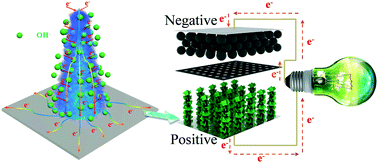Designing positive electrodes based on 3D hierarchical CoMn2O4@NiMn-LDH nanoarray composites for high energy and power density supercapacitors†
Abstract
Herein, a positive electrode based on three-dimensional (3D) hierarchical CoMn2O4@NiMn-LDH core–shell nanowire arrays was successfully prepared on Ni foam via hydrothermal and calcination methods. The skeleton of the CoMn2O4 nanowire arrays was in situ developed on Ni foam substrates, and hierarchical NiMn-LDH nanosheets were homogeneously overlapped on the surface of CoMn2O4 nanowires. Electrochemical measurements revealed that this electrode represented the faradaic process of battery-type charge storage and exhibited a high specific capacity of 313 mA h g−1 (under 1 A g−1). The corresponding hybrid supercapacitor device, which was assembled by a CoMn2O4@NiMn-LDH cathode and activated carbon anode, possessed a high energy density of 118.8 W h kg−1 with a power density of 799.4 W kg−1. With two devices connected in series, the output voltage could reach 3.2 V and successfully assisted a group of light-emitting diodes turning on. This study provides an efficient strategy to develop next-generation high-performance energy storage devices.



 Please wait while we load your content...
Please wait while we load your content...